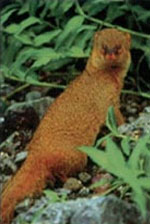Mortality Threats to Birds - Small Indian Mongoose (Herpestes javanicus)
Overview
Originally from Asia, mongoose were deliberately introduced in the 1800s into Puerto Rico, the Dominican Republic, West Indies and Hawaiian islands in an attempt to control black rats in sugarcane fields. They quickly spread and have become serious pests. Mongoose eat the eggs and young of many ground-nesting birds and have caused the decline or extinction of many endemic birds, small mammals and reptiles, including snakes and iguanas. They continue to cause economic loss to the poultry industry, and pose a disease risk because they can carry and spread diseases such as rabies and leptospirosis. Mongoose can survive in a wide range of habitats including desert, grasslands, wetlands and natural forest. Mongooses hunt small animals by day and can climb trees.
Description
Very high reproductive rate; breeds 2-3 times/year, producing litters of 3 young, and can breed as early as 10 weeks of age. Short, dense fur, tan to brown in color, with paler undersides. Bushy tail can be as long as the body. Feeds on insects, spiders, snails, slugs, frogs, lizards, snakes, birds, bird and reptile eggs, rodents, crabs, fish and fruits. Live in small burrows.
Birds Affected
Ground-nesting birds such albatrosses, petrels, boobies, and shearwaters. They are considered to be the number one predator against the endangered Nene, eating the eggs and incubating females. They also eat the eggs and adults of many forest birds, including `Alala.
Control
Trapping and poisoning with anticoagulants are the most common means of control (though potential hazards to birds of these chemicals require specific wildlife training for applicators). Trapping has been used extensively on many nature reserves. Mongoose have also been shot, or poisoned using either aerial drops of poison or bating with poisoned carrion. |
